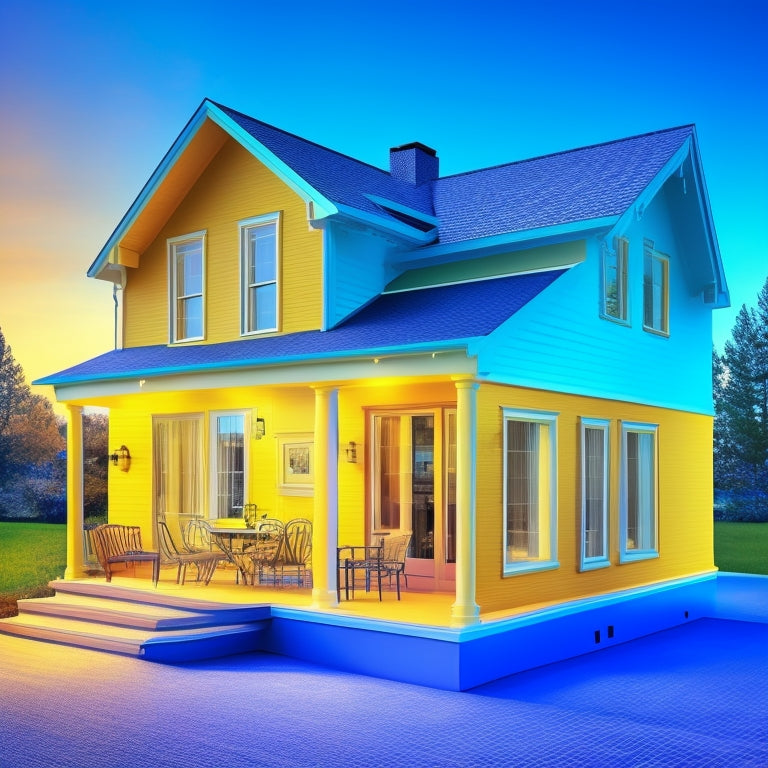
Why Use Infrared Cameras to Detect Home Energy Leaks?
Share
You're losing money and energy every day due to hidden leaks in your home that can be easily detected and resolved with infrared cameras. These thermal imaging tools reveal temperature anomalies in building envelopes, pinpointing heat escape or entry locations. By using infrared cameras, you can identify insulation gaps, moisture issues, and electrical hazards, leading to significant utility bill savings. Regular energy audits are recommended to identify improvement areas, and knowledge gained helps prioritize energy-efficient upgrades. As you investigate the benefits of infrared cameras in energy auditing, you'll uncover an all-encompassing approach to optimizing your home's energy efficiency, safety, and overall performance.
Key Takeaways
- Infrared cameras detect temperature anomalies, pinpointing heat escape or entry locations, and facilitating prioritization of repairs and upgrades.
- Thermal imaging reveals insulation gaps, thermal bridging, and hidden moisture, enabling targeted energy-efficient upgrades and preventing structural damage.
- Infrared cameras identify electrical issues, such as overheating and faulty wiring, reducing fire hazards and ensuring safe EV charger installation.
- Regular energy audits with infrared cameras optimize energy usage, reduce energy bills, and enhance overall energy performance and home safety.
- Data-driven decisions from infrared camera inspections lead to corrective actions, improving insulation effectiveness and promoting a comfortable, cost-effective living space.
Detect Hidden Energy Loss
Detecting hidden energy loss in your home can be an intimidating task, especially when you're not sure where to start. That's why a thorough energy assessment is vital in identifying areas of inefficiency.
Shifting to sustainable infrastructure, including efficient charging solutions, is essential for reducing reliance on fossil fuels and aiding in climate change mitigation sustainable infrastructure.
One effective method is thermal imaging, which uses specialized cameras to detect temperature anomalies in your home's building envelope. By capturing infrared images, you can pinpoint exactly where heat is escaping or entering your home.
This allows you to prioritize repairs and upgrades, ensuring your hard-earned money isn't being wasted on unnecessary energy bills. With thermal imaging, you'll gain a clear understanding of your home's energy performance, enabling you to take control of your energy usage and make data-driven decisions.
Reduce Heating and Cooling Costs
By pinpointing hidden energy leaks with thermal imaging, you can greatly reduce your heating and cooling costs, which account for nearly half of your energy bills.
In fact, a single infrared inspection can identify areas where energy is escaping, allowing you to take corrective action and optimize your home's energy efficiency.
Implementing renewable energy solutions, such as solar energy implementation, can also contribute to a cleaner and more sustainable environment.
By sealing these energy leaks, you'll enjoy significant cost savings on your utility bills. This is especially important for homeowners who value freedom from financial burdens.
With thermal imaging, you can create a more energy-efficient home, reduce your carbon footprint, and keep more money in your pocket.
Identify Insulation Gaps Easily
Identify Insulation Gaps Easily
As you use thermal imaging to scan your home's insulation, you'll quickly spot areas where heat is escaping, indicating gaps in the insulation. This is essential because insulation materials can settle or become damaged over time, leaving your home vulnerable to heat loss. Infrared cameras help you identify these gaps, allowing you to take corrective action.
| Insulation Issue | Thermal Imaging Indicator |
|---|---|
| Gaps in batt insulation | Uneven heat patterns or hot spots |
| Thermal bridging | Unusual heat signatures around studs or framing |
| Insulation damage | Cold spots or areas with reduced temperature |
| Inadequate insulation | Overall heat loss or uneven temperature distribution |
Pinpoint Moisture and Mold Issues
In your home's walls, ceilings, and floors, hidden moisture issues can lead to mold growth, structural damage, and unhealthy indoor air quality. Infrared cameras can help you detect these issues before they become major problems.
Additionally, the environmental impact of electric vehicles, such as resource depletion, can be mitigated by addressing energy efficiency in our homes.
With infrared technology, you can:
- Identify areas of high humidity and moisture detection, preventing mold growth and structural damage
- Detect water leaks and condensation issues behind walls and under floors
- Guarantee proper humidity control and air quality by identifying areas of poor ventilation, which can be exacerbated by the increased demand for electric vehicles and their charging infrastructure
- Prevent costly repairs and maintain a healthy living space by addressing moisture issues early
Enhance Home Safety and Security
By using an infrared camera, you'll be able to reduce fire hazards by detecting overheated electrical components and identifying potential ignition sources.
It's also essential to confirm that your home's electrical system can handle the increased power load capacity required by an EV charger. Hiring a licensed electrician can guarantee a safe and code-compliant installation.
You'll also be able to identify electrical issues, such as faulty wiring or overloaded circuits, that can lead to electrical shocks or fires.
Additionally, you'll be able to prevent carbon monoxide poisoning by detecting heat signatures from faulty HVAC systems or appliances that can lead to CO buildup.
Reduce Fire Hazards
About 75% of electrical fires occur in residential areas, often due to faulty or damaged wiring, and overheated electrical components.
As electric vehicles like trucks and SUVs become more sustainable, it's essential to prioritize home safety and security.
By using infrared cameras to detect energy leaks, you can greatly reduce the risk of electrical fires. This is especially important in areas with poor insulation materials, which can exacerbate heat buildup.
You can:
- Identify overheated electrical components and take corrective action
- Detect faulty or damaged wiring and replace it before it causes a fire
- Implement fire prevention techniques, such as installing smoke detectors and fire alarms
- Guarantee that your home is well-maintained and safe, giving you peace of mind and freedom from worry.
Identify Electrical Issues
You can pinpoint electrical issues in your home by using infrared cameras to scan for unusual heat patterns, which often indicate faulty or damaged electrical components.
These heat patterns can indicate electrical overheating, a common sign of worn-out wiring insulation or loose connections. By detecting these issues early, you can prevent electrical fires and safeguard your home's safety.
With the increasing adoption of electric vehicles, it's important to evaluate the impact of high-power charging on electrical systems, and infrared cameras can help identify potential overheating issues.
Infrared cameras can also help you identify overheated electrical panels, outlets, and circuit breakers, allowing you to take corrective action before a serious problem develops.
Prevent Carbon Monoxide
Vulnerability to carbon monoxide poisoning lurks in every home, often masked by the invisible and odorless nature of this deadly gas.
You can take proactive measures to prevent carbon monoxide poisoning by using infrared cameras to detect potential sources of CO leaks. This includes:
- Identifying faulty or malfunctioning heating systems, water heaters, and other fuel-burning appliances
- Detecting cracks in furnace heat exchangers or chimneys that can allow CO to seep into your home
- Pinpointing areas where CO may be accumulating due to poor ventilation or air quality issues
- Verifying the proper function of carbon monoxide detectors and ensuring they're installed in strategic locations throughout your home
Comply With Building Code Regulations
You'll need to comply with building code regulations, which increasingly mandate energy efficiency in new and existing homes.
In particular, you'll need to verify your home meets energy audit requirements, which can be streamlined with the use of infrared cameras.
Code Mandates Energy Efficiency
Most building codes in the United States, including the International Energy Conservation Code (IECC), require new residential construction to meet specific energy efficiency standards.
You must guarantee your home complies with these regulations to avoid costly fines and penalties.
-
Building codes dictate the minimum energy standards for new construction, including insulation, windows, and doors.
-
You're required to meet specific energy efficiency levels for heating and cooling systems, lighting, and appliances.
-
Energy efficiency standards vary by climate zone, so you need to familiarize yourself with local regulations.
- Failure to comply with building codes can result in construction delays, fines, and even legal action.
Energy Audit Requirements
Five key areas of your home must be assessed during an energy audit to comply with building code regulations: the building envelope, HVAC systems, lighting, appliances, and insulation.
You'll need to identify energy-wasting areas and opportunities for improvement in these areas to reap the energy audit benefits.
The energy audit process typically involves a visual inspection, diagnostic testing, and infrared thermal imaging.
By conducting an energy audit, you'll gain an extensive understanding of your home's energy usage, allowing you to prioritize energy-efficient upgrades and optimize your energy consumption.
This won't only help you comply with building codes but also increase your energy independence and reduce your environmental footprint.
Optimize Home Energy Efficiency
Because energy efficiency is a crucial aspect of maintaining a comfortable and cost-effective living space, optimizing your home's energy performance is necessary.
By identifying areas of energy inefficiency, you can take targeted steps to reduce energy waste and create a more sustainable living environment.
Some key strategies to contemplate include:
- Conducting regular energy audits to identify areas for improvement
- Investing in smart home technologies to optimize energy usage
- Improving home insulation to reduce heat loss and gain
- Utilizing thermal imaging to pinpoint energy leaks and prioritize repairs
Frequently Asked Questions
Can I Use an Infrared Camera to Detect Energy Leaks in My Business?
You can definitely use an infrared camera to detect energy leaks in your business, identifying areas where insulation is lacking and optimizing energy efficiency, ultimately reducing costs and increasing your company's freedom to allocate resources.
Are Infrared Cameras Difficult to Use and Require Special Training?
You'll find that most infrared cameras are designed with user-friendly features, making them easy to operate, and often come with detailed training resources, so you can start detecting energy leaks quickly and confidently, without needing extensive knowledge.
Can I Rent an Infrared Camera Instead of Buying One?
Aren't you tired of throwing money out the window? You can rent an infrared camera for a fraction of the cost, comparing rental options to buying, and still detect those sneaky energy leaks, giving you the freedom to save big!
How Accurate Are Infrared Camera Readings in Detecting Energy Leaks?
You'll find infrared camera readings are highly accurate in detecting energy leaks, thanks to advanced infrared technology that pinpoints temperature variations, helping you optimize energy efficiency and take control of your home's energy consumption.
Do Infrared Cameras Only Detect Energy Leaks or Can They Detect Other Issues?
You'll find that infrared cameras don't just detect energy leaks; they also identify other issues, such as water damage, electrical hotspots, and structural defects, thanks to the broader thermal imaging benefits in various building inspection applications.
Related Posts
-

What Tax Deductions Apply to Sustainable Building Materials?
You can claim various tax deductions for sustainable building materials, thanks to over 40 federal tax incentives sup...
-

3 Best Solar-Powered Biodegradable Accessories for Your Home
You're taking a significant step towards a more sustainable lifestyle by incorporating solar-powered biodegradable ac...
-

7 Smart Air Purification Hacks for Energy-Savvy Homes
You can notably improve your indoor air quality while minimizing energy consumption by implementing strategic air pur...


